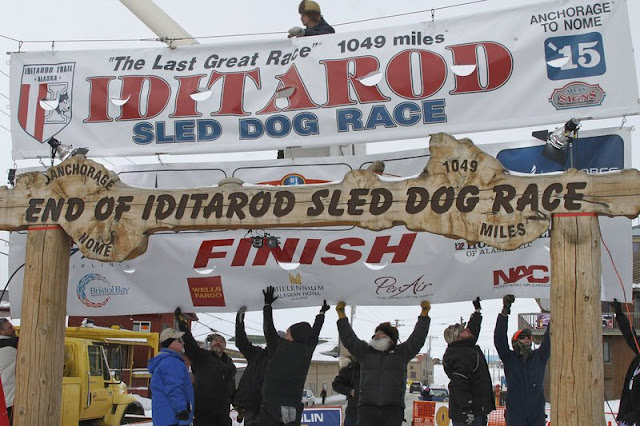It is a tiny, remote place. But it isn't all that far north (roughly about the middle of Sweden latitude-wise). Nothing good happens in Alaska without the cooperation of the weather. Nome was no exception:
 |
| Foggy, mid 50's, with a 4 - 5 foot swell. Ironically, a couple days earlier Nome broke an all-time high record with an 86 degree sunny day. (5 degrees hotter than previous record). |
Nome doesn't have a harbor big enough for a cruise ship so it was tender time:
I had booked an early morning photography tour (hoped to see musk ox, caribou, pandas, - the usual cast of Alaskan characters) so I was able to get aboard the first tender headed to shore. Boarding a tender in 3 foot seas (even though the captain maneuvered the ship to shelter the tenders in it's lee) is not for people with mobility issues. We did, however, manage to load up a group of determined souls and headed into the small harbor. Victory was short-lived as we were not allowed to disembark. The deteriorating weather forced us to return to the ship while we still could. This was probably a very wise move as Nome is a village of only 3,800 people. Stranding several hundred tourists on shore would have been a serious problem. I really felt sorry for the mayor of Nome as they had organized a berry festival for us (Nome only gets 4 cruise ships a year). On the way in I was able to get a hint of what the place is all about:
 |
| Jack-up rig |
If you guessed gold prospecting, you're correct. Long before gold was discovered for the first time (1898) the place was just a fishing camp for the Inupiat natives. Note - Don't call them Eskimos. The Inupait can trace their roots to the Inuits. The Inuits, in turn, are the people who inhabit the entire "circumpolar" (top of the world) region (including northern Greenland, upper Canada, Siberia). The Inupaits probably knew there was gold lying around, but since you can't eat gold and it won't keep you warm - they could not have cared less. No so the "Three Lucky Swedes" who stumbled across gold in Anvil creek in 1898. Word leaked out and within a year Nome had 10,000 prospectors scratching around. They found gold just sitting in the sand on the beaches - which drove the gold frenzy to new heights.
 |
| In 1900 the tent city on the beach stretched more than 30 miles |
One such hopeful was none other than Wyatt Earp himself (Tombstone Arizona to Nome must have been quite a trip). By the turn of the century Nome was the largest city in Alaska (boasting 60 saloons). It was a rowdy, mostly lawless frontier town. As usual, wherever there's money - some shady politician will try to figure out a way to get their hands on it without having to go out and dig it up themselves. Enter the Donald Trump of the era - Alexander McKenzie. McKenzie was a sleazy politician from North Dakota known as "the senator-maker". He was head of the RNC for many years. He managed to appoint an equally corrupt federal judge to handle all the claim jumper lawsuits. Between the two of them they conspired to rob anyone dumb enough to enter their court (both eventually were sent to prison). This spectacle of injustice inspired Rex Beach to write the best selling novel 'The Spoilers' in 1906.
 |
| Rex Beach. Author and Olympic water polo player. |
'The Spoilers' inspired no less than 5 Hollywood movies.
 |
| By Source (WP:NFCC#4), Fair use, https://en.wikipedia.org/w/index.php?curid=36820561 |
In 10 years the gold fields had played out for the technology available at the time and Nome's population shrank back to 2,500. The majority of today's population of 3,800 continues to prospect for gold (it is estimated that 1,000,000 troy ounces remain). This, of course, makes for reality TV fodder:
 |
| Is it just me or does this look like a vial of sand? |
 |
| Gold Rush |
After the initial gold rush frenzy, Nome would have faded into obscurity except for an epidemic one awful winter in 1925.
 |
| 1916 |
The town's only doctor (Curtis Welch) initially thought he had a few cases of tonsillitis on his hands. When 4 of his patients died however, he knew he had a much worse problem - diphtheria. Diphtheria is a bacteria infection that is easily transmitted and can quickly spread. The toxin it secretes is rather nasty and can cause all kinds of life-threatening symptoms. Antitoxin is critical to saving the life of anyone infected.
 |
| 1895 vial of antitoxin |
The tiny Nome hospital actually had some vials of antitoxin, but they had all expired. Dr. Welch tried the expired antitoxin on his next patient, a 4 year old girl. She died within hours. The harsh winter conditions precluded any chance of flying in fresh serum. In 1925 there were only 3 airplanes in all of Alaska (all Standard J open cockpit biplanes, dismantled for winter storage, and no pilots).
 |
| Standard J biplane - NOT something you want try to fly in an Alaskan winter. No heater, no anti-icing, unreliable engine, short range, navigation by compass ground observation and prayer. |
Shipping by sea would take too long as Nome was icebound and no ship could get into port until spring. To make matters worse, diphtheria antitoxin is rather fragile. Welch calculated that it would survive for only 6 days outside in the harsh winter conditions. Things were looking grim, to say the least. The town folks that had moved to Nome from the lower US had only a slight chance of surviving an infection. The Alaskan natives had no immunity, hence, no chance at all. Welch put out a radio telegram call for help. There simply wasn't any antitoxin anywhere close. Then, by an incredible stroke of luck, the chief surgeon of the Anchorage Railroad Hospital found a small supply of forgotten antitoxin in a back storeroom. It was immediately shipped via rail to end of the line - Nenana, still 674 miles away from Nome. The day was saved by "The Great Race of Mercy". 20 mushers and 150 sled dogs managed to make the 674 mile run from Nenana to Nome in just 5 1/2 days - saving the town. The sled teams endured whiteout conditions -70 temps and gale force winds. It was a truly miserable trip. At some stops they had to pour hot water over the gloves of the handlers to get them off the sled handlebars.
The saga received widespread radio coverage and captured the imagination of the world. So who were these heroic mushers? Mailmen, mostly native Alaskans. While all the mushers survived (some with severe frostbite) not all of the dogs did. The team that made the last push to Nome became quite famous in the lower 48.
 |
| Gunnar Kaasen with his dog, Balto |
Balto did one helluva job. At points during the run Gunnar reported conditions were so bad that he couldn't even see the dog closest to the sled. Balto, however, managed to navigate in those conditions and saved the day (by contrast my wimpy dog gets lost walking more than a block away from the house in broad daylight).
While Balto got most of the glory in the lower US, he isn't considered the real hero to Alaskans.
In 1973 Alaskans organized the Iditarod Trail Sled Dog Race. The word Iditarod has been variously ascribed to the Idatarod river, "Clear Water", "distant place".
 |
| Krista Heeringa |
Initially it was merely a way to compare dog teams mushers and dogs, but managed to capture (once again) world public interest.
 |
| Not all dogs get the hang of it. |
With some much attention focused on the race, naturally it became highly competitive. It has been referred to as 'The Last Great Race on Earth'. Today's Iditarod is billed as Anchorage to Nome (1,049 brutal miles). They have a ceremonial start in Anchorage:
but the real race starts in Willow, about 80 miles north of Anchorage. Generally about 50 teams and 1,000 dogs race.
The end of the race:
Race result times vary greatly. The fastest time to traverse the route is 8 days 3 hours set in 2017. In 1974 it took poor Carl Huntington more than 20 days to win the race.












